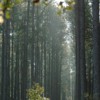Abstract
Thinning is an important silvicultural practice that redistributes the growth potential of the site to the best trees. Diameter growth rates are maintained or increased on residual trees after thinning, which increases the return on investment from higher-value trees. Biologically, thinning accelerates stand development by favoring the tallest, best-formed trees over those that are diseased, overtopped, crooked, forked, or otherwise undesirable and likely to die on their own if left in the stand long enough. In addition, thinning provides periodic income, improves access for equipment, recreation and hunting, and creates a generally healthier stand. Thinning is also beneficial for wildlife, especially when combined with prescribed fire or herbicide use to control competing vegetation. By allowing more light to reach the forest floor, thinning promotes growth of plants important as food and/or cover for wildlife species. Landowners are encouraged to consult with or hire a professional forester to assist with thinning and other forest management activities. This 6-page fact sheet was written by Chris Demers, Michael Andreu, Babe McGowan, Alan Long, and Jarek Nowak, and published by the UF Department of School of Forest Resources and Conservation, July 2013.
References
Davis, L.S. and K. N. Johnson. 1987. Forest Management. McGraw-Hill Publishing Co., NY. 790 pp.
Harrington, T. B. 2001. Silvicultural approaches for thinning southern pines: method, intensity, and timing. Georgia Forestry Commission, Publication #FSP002. 17 p.
Harrington, T. B. 2001. Silvicultural basis for thinning southern pines: concepts and expected responses. Georgia Forestry Commission, Report #FSP001. 13 p.
Meeker, J. R., W. N. Dixon, J. L. Foltz, and T. R. Fasulo. 2004. Southern Pine Beetle, Dendroctonus frontalis Zimmermann (Insecta: Coleoptera: Scolytidae). EENY-176 Entomology and Nematology Department, Cooperative Extension Service, Institute of Food and Agricultural Sciences, University of Florida. 6 pp.
Smith, D. M., B. C. Larson, M. J. Kelty, and P. M. Ashton. 1996. The Practice of Silviculture: Applied Forest Ecology, 9th ed. John Wiley and Sons, Inc. New York. 560 pp.
Schmidt, R. A. 1998. Rust Disease of Southern Pines: Biology, Ecology and Management. Bul. 903. School of Forest Resources and Conservation, University of Florida, Institute of Food and Agricultural Sciences, Gainesville. 8 pp.
Williston, H. L., W. E. Balmer, and D. Tomczak. 1998. Managing the Family Forest in the South. Management Bulletin R8-MB 1, USDA Forest Service. Atlanta. 92 p.
Unless otherwise specified, articles published in the EDIS journal after January 1, 2024 are licensed under a Creative Commons Attribution-NonCommercial-NoDerivs 4.0 International (CC BY-NC-ND 4.0) license.

